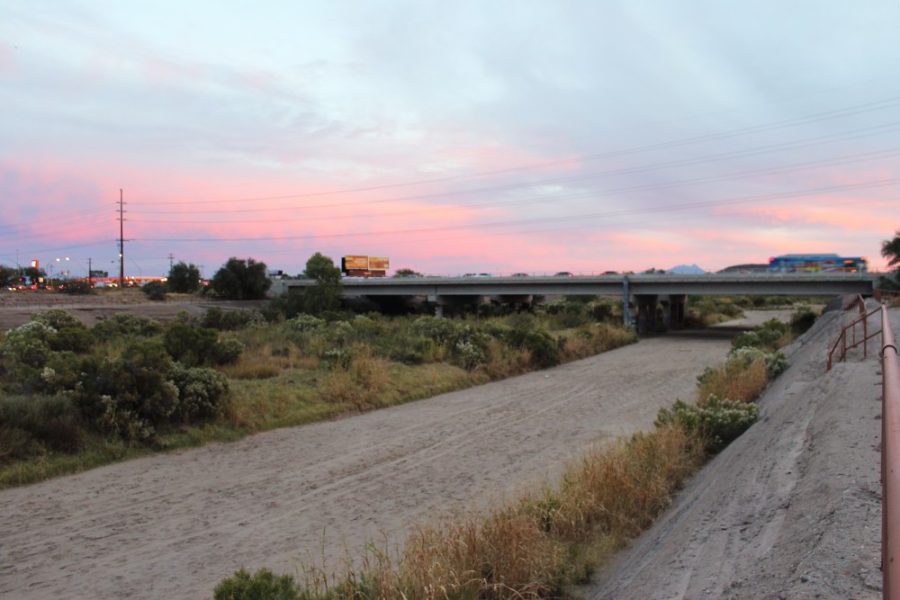Tucson Water has proposed moving the reclaimed water discharge sites in the Santa Cruz River further upstream closer by the downtown Tucson area through their Agua Dulce Santa Cruz River Heritage Project, with hopes of restoring flow to the river within two years.
The move would allow Tucson Water to have more control, both legally and physically, over the water, according to Tucson Water public information officer Fernando Molina.
There are already existing pipes to discharge the water, which comes from Tucson Water’s unused portion of reclaimed water from Pima County’s wastewater treatment facilities, into the Santa Cruz River at 29th Street and at Ina Road. The proposal would move these discharge sites to Silverlake Road and to Cushing Street, Molina said.
Around half of Tucson Water’s recycled water is used mostly for irrigation, but the other half is discharged into the river. Tucson Water has looked into how to use that water, initially considering purifying it for drinking water for the last couple years, according to Molina.
RELATED: Community Garden water cistern benefits sustainability while cutting costs
He said that process can be very expensive, though, and there isn’t a need for the extra water at this time; moreover, if there is ever a need to use the water, Tucson Water can pump it out to be purified.
Molina said there aren’t many new reclaimed water customers who would use the water now.
“Historically, we thought we would see growth in the number of customers that were looking for this recycled water, but that’s not happening, and in fact it’s actually reducing over time,” Molina said. “We just had an opportunity to rethink what we were doing and looked at this as a really viable alternative.”
One part of the plan’s viability is that it will not be very expensive, because there is already a major water pipeline that is “pretty much where” it needs to be to put the water into the river, according to Molina.
He said Tucson Water does not need much new infrastructure, reducing cost potentials there and the improvements to be made to the reclaimed water system are already in the capital budget monies, and Tucson Water programs are funded by rate payers.
In addition to creating a regular water flow in the Santa Cruz River in the downtown Tucson area, the proposal would also make water available for a small water feature, such as a small river or channel, that could be constructed with private funds through the Rio Nuevo development area. The water would then flow through the feature and enter the Santa Cruz River.
RELATED: Students for Sustainability’s Dien Truong stresses the importance of water conservation
“A long-term benefit to the taxpayer community is by having that feature in there that would spark investment in economic development in that area,” Molina said.
The proposed move of the water’s discharge sites could also impact the environment.
Claire Zugmeyer, an ecologist with the Sonoran Institute who works on the Santa Cruz River Initiative, said this change in location of water flow could reduce the flows in the current stretch where the water is discharged.
Molina said there will still be water flowing in that area, though, from other organizations’ water discharge with the Pima County Wastewater Treatment facilities.
As for Tucson’s rainy days, which sometimes can lead to flooding, Molina said they don’t see the proposal impacting the area and its function because there isn’t a lot of water added.
“We’re not talking about the river flowing bank to bank; we’re talking about just a little ribbon of water flowing down into the river bed,” he said. “If there are flows, we could probably stop putting that water in there, just let the natural water that’s going to flow through flow through.”
Zugmeyer said it would be exciting to see the downtown stretch of the Santa Cruz flowing again and that she imagines the flow would increase riparian and aquatic life in the area.
“It would be an interesting opportunity to track before and after conditions,” Zugmeyer said.
Jean McLain, the associate director of the UA Water Resources Research Center and a water quality specialist and water microbiologist at the UA, said the project looks positive from an environmental perspective.
“We [at the Water Resources Research Center] really don’t take sides; we present the facts,” McLain said. “But the facts seem to indicate that this is going to be a win-win for Tucson and for the environment.”
The proposal would not be implemented for another year and a half to two years, Molina said, because Tucson Water still needs to do some research and design and construct outlet structures for the water’s release.
“We could get a nice river habitat alongside the river in the downtown area where people can actually see it, go to it, benefit from it, as opposed to now,” Molina said. “It’s pretty much in remote areas and very few people actually get out there.”
Follow Ava Garcia on Twitter.









